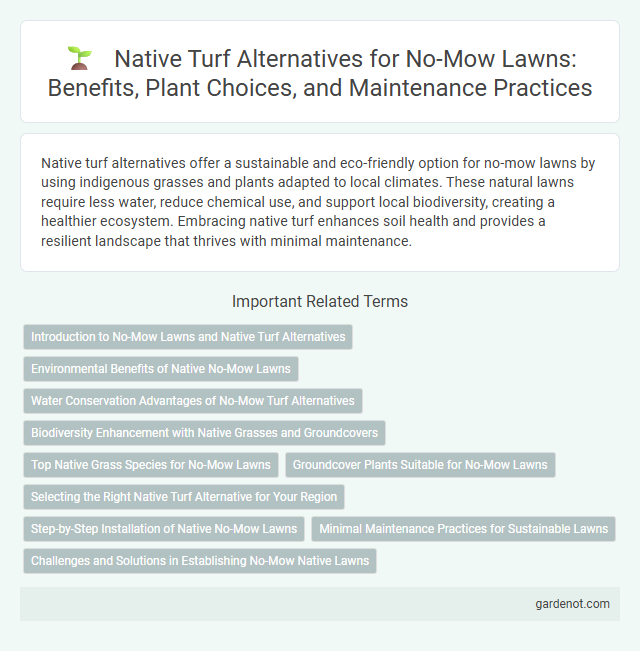Native turf alternatives offer a sustainable and eco-friendly option for no-mow lawns by using indigenous grasses and plants adapted to local climates. These natural lawns require less water, reduce chemical use, and support local biodiversity, creating a healthier ecosystem. Embracing native turf enhances soil health and provides a resilient landscape that thrives with minimal maintenance.
Introduction to No-Mow Lawns and Native Turf Alternatives
No-mow lawns feature native turf alternatives that require minimal maintenance while supporting local biodiversity. These lawns incorporate drought-resistant grasses and native wildflowers, reducing water use and eliminating the need for frequent mowing. Native turf alternatives promote healthier ecosystems by providing habitats for pollinators and improving soil health in residential landscapes.
Environmental Benefits of Native No-Mow Lawns
Native no-mow lawns significantly reduce water consumption compared to traditional turf, promoting sustainable landscape management. These lawns enhance biodiversity by providing habitat for local pollinators and beneficial insects, contributing to ecosystem health. Their deep root systems improve soil quality and reduce erosion, while naturally sequestering carbon and lowering greenhouse gas emissions.
Water Conservation Advantages of No-Mow Turf Alternatives
No-mow turf alternatives significantly reduce water consumption by eliminating the need for regular irrigation compared to traditional grass lawns. Native plant-based no-mow lawns utilize deep-rooted species like buffalo grass and fescue, which are drought-resistant and thrive with minimal supplemental watering. This natural adaptation not only conserves water resources but also enhances soil moisture retention and supports local biodiversity.
Biodiversity Enhancement with Native Grasses and Groundcovers
Native turf alternatives composed of diverse native grasses and groundcovers significantly boost biodiversity by providing habitat and food sources for pollinators, beneficial insects, and local wildlife. These plant communities improve soil health through deep root systems that enhance aeration and nutrient cycling while reducing erosion. Implementing native species reduces the need for chemical inputs and mowing, promoting a sustainable, ecologically balanced lawn ecosystem.
Top Native Grass Species for No-Mow Lawns
Top native grass species for no-mow lawns include Buffalo grass (Bouteloua dactyloides), known for its drought tolerance and low maintenance needs, and Fine fescue varieties (Festuca spp.), which thrive in shade and require minimal mowing. Blue grama (Bouteloua gracilis) offers excellent erosion control and sustains green color with minimal watering. These native turf alternatives support local ecosystems, reduce water consumption, and eliminate the need for frequent mowing.
Groundcover Plants Suitable for No-Mow Lawns
Groundcover plants such as creeping thyme, sedum, and clover offer excellent native turf alternatives for no-mow lawns by providing low-maintenance, drought-tolerant coverage that suppresses weeds and supports local pollinators. These species thrive in various soil types, require minimal watering, and create a durable, green landscape without the need for frequent mowing or chemical treatments. Selecting native groundcovers enhances soil health and biodiversity while significantly reducing lawn care time and environmental impact.
Selecting the Right Native Turf Alternative for Your Region
Choosing the right native turf alternative involves selecting grasses and groundcovers naturally adapted to your region's climate and soil conditions, which ensures low maintenance and drought resistance. Consider species like Buffalo Grass in arid zones, Fescues in cooler climates, and Zoysia for warmer areas, as these native options thrive without frequent mowing or excessive watering. Proper site assessment and local extension resources are essential to match the best native turf alternative to your landscape's ecological requirements.
Step-by-Step Installation of Native No-Mow Lawns
Installing native no-mow lawns begins with selecting region-appropriate grass species such as buffalo grass, blue grama, or fine fescues that thrive in local soil and climate conditions. Preparing the soil involves minimal tilling to preserve beneficial microbes, followed by spreading seeds evenly and lightly raking them into the surface for optimal germination. Regular watering is essential during the first few weeks, tapering off as the native turf establishes deep roots, reducing maintenance and eliminating the need for mowing.
Minimal Maintenance Practices for Sustainable Lawns
Native turf alternatives require minimal maintenance, significantly reducing water usage and eliminating the need for chemical fertilizers and pesticides. These sustainable lawns thrive with occasional mowing, usually just once or twice per season, promoting biodiversity and soil health. Adopting native grasses such as buffalo grass or fescues supports resilient ecosystems while cutting long-term lawn care costs.
Challenges and Solutions in Establishing No-Mow Native Lawns
Establishing no-mow native lawns presents challenges such as slow initial growth, weed invasion, and selecting appropriate species adapted to local soil and climate conditions. Solutions include proper site preparation, using seed mixes tailored for regional ecosystems, and implementing targeted weed management techniques during establishment. Long-term success relies on patience and periodic monitoring to ensure native turf thrives with minimal maintenance.
Native turf alternative Infographic

 gardenot.com
gardenot.com